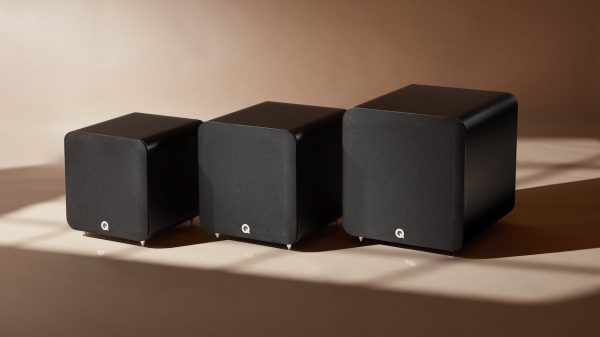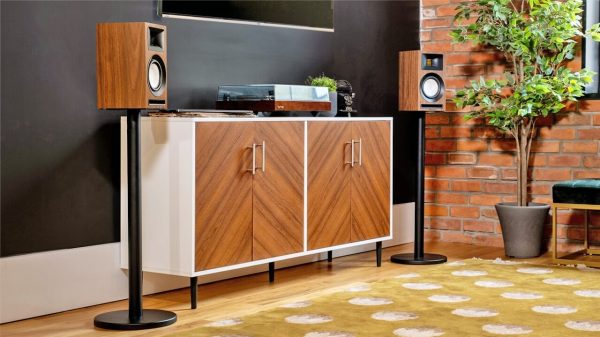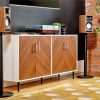Table of contents
Introduction
Will any of us still be using passive loudspeakers by the end of the decade? We suspect that more and more audiophiles will be making the change as the sonic performance improves with each new product cycle. It is inevitable. It is your destiny.
Look at the popularity of Sonos as a mainstream consumer audio brand, or the technical performance of loudspeakers like the Dynaudio Focus 50?
It really needs to be asked — why can’t a pair of high-end wireless loudspeakers with multiple connectivity options and a subwoofer output work for 99% of the population?
Brands like PSB, Bowers & Wilkins, Sonus faber, ELAC, Focal, Triangle, Dynaudio, Klipsch and KEF are leveraging their future on the bet that the new generation of audiophiles are going to demand wireless and the ability to integrate legacy devices and home theater into that system.
Our picks for the best wireless speakers range from $269 to $11,000 and all of them offer something unique at their specific price point.
Consumers want usability and the best possible sound quality at a price that they can afford. Our selections for the best affordable wireless speakers offer both performance, flexibility, and a lot of value for the money — even at the very top of the market.
The future is fewer components with only a network player, turntable, or gaming console as possible sources.
Audiophiles are reluctant to go wireless unless the speakers can support TIDAL Connect, Spotify Connect, Chromecast, or are Roon-Ready like the KEF LS50 Wireless II loudspeakers.
What to look for?
Support for Bluetooth aptX HD, aptX Adaptive or aptX Low Latency, along with LDAC, AAC, SBC, and Apple AirPlay 2 is a good place to start, but you are unlikely to find all of that from one product.
The concept of “wireless” is also misleading. Every wireless or Bluetooth loudspeaker requires a physical connection to a power source and some models come with an Ethernet cable to connect a primary speaker to the secondary one, and some even come with loudspeaker cables because only one of the two speakers includes the power amplifiers required to drive both.
Development of a proprietary control app is an expensive endeavour for some brands and you may be required to cast directly from your music streaming app on your smart device to the speakers instead.
Support for hi-res audio has become more popular and you are unlikely to find models going forward that don’t utilise a 24-bit/192kHz DAC (or higher) internally — but that doesn’t mean you are able to stream that from your device unless it supports the proper codec or the speakers are connected online to the music streaming platform and your device becomes the remote.
Look for models that include a MM/MC phono pre-amplifier or have RCA line level inputs so that you can connect an external one. TOSLINK Optical or 3.5mm to RCA inputs are also important if you have any legacy source components that you might to still use.
HDMI ARC or eARC connections have become more important for consumers who plan on using their wireless speakers for both music and TV/movies. A single HDMI can connect such wireless speakers to a TV, which essentially provides the functionality of a soundbar, while allowing your TV’s remote to control volume.
Sound quality has to matter. The flexibility of wireless connectivity is a great feature, but don’t buy any wireless or Bluetooth loudspeaker unless the sonic performance really engages you.
Note: This list below excludes portable Bluetooth speakers, which will be awarded separately.
Best Wireless Speakers Under $300

Audioengine A2+ ($269)
You know that the market still likes a product when the manufacturer keeps adding new colors and there is no plan to replace it. The $269 Audioengine A2+ have been part of their lineup for 4 years and they might be ideal for college students or even your own desktop if you don’t have a lot of room.
Having purchased two pairs for both of my college students who rave about the setup, ability to transport them, and overall sound quality – I know they remain rather relevant below $300.
Kanto and Sonos offer more affordable options, but the A2+ seem to work for a lot of people and not being tied to a native control app makes them even more appealing.
The Audioengine A2+ speakers sound much larger than they look; their 2.75” aramid fiber woofer and ¾” silk dome tweeter driven by an internal Class A/B 60-watt amplifier (30 watts per channel) can more than keep up with the music when pushed, but don’t expect them to work miracles.
Audioengine includes an internal 16-bit/48kHz DAC, and whilst that certainly suffices for MP3s and CD Red Book, the addition of an external 24-bit/96kHz or even 32-bit/384kHz and DSD DAC makes them perform even better. Better resolution, tighter bass, and improved transparency.
Invest in stands. Your listening height at your desk is not the same as your favorite chair in the living room.
A desktop computer speakers system creates a near field listening situation; your listening position is much closer to the loudspeaker which will minimize the impact of the sound reflecting off surfaces like your desk, computer monitor, ceiling, and walls beside and behind you.
The A2+ delivers a rather warm and punchy presentation and one can add a subwoofer if you desire the bottom octaves in a smaller space.
Pros:
- Ideal for the desktop
- Value for the money
- Punchy and warm presentation
- Very easy to setup
- Subwoofer output
- Solid build quality
Cons:
- Limited to 16-bit/48kHz PCM unless you add an external hi-res DAC or source
- No phono pre-amplifier
- Might require a subwoofer depending on the setup and room size
- Need stands
Where to buy:
Best Wireless Speakers Under $500

Q Acoustics M20 HD ($499)
There will always be a market for high-end audio components but the future is clearly products like the Q Acoustics M20 HD Wireless Speaker System.
The $699 M20 HD Wireless Speaker system is similar in some ways to the Q Acoustics 3020i but with two big differences; more low end punch and a surprisingly larger sense of scale. Something that came in handy listening to Tchaikovsky, Dvorak, and Mozart.
The M20 isn’t designed for a huge listening space but it had zero difficulty filling my dining room, home office, and den with excellent sound; transparent, spacious, and stronger bass than I would have expected.
The Q Acoustics M20 offer aptX HD Bluetooth connectivity for wireless streaming of high resolution-quality audio from devices such as smartphones, tablets, laptops and network streamers; users can hear their favorite music streamed from popular music services such as Spotify, Tidal, Deezer, Apple Music, Amazon Music, Qobuz and YouTube.
The versatile M20 can also deliver sounds from a gaming console, TV, turntable, set-top box, CD player or even a DAP.
The M20 are powered by a built-in amplifier (class D) providing 130 watts of digital power, the 22mm tweeter is decoupled to minimize any internal vibrations that can adversely affect the audio, while the 125mm mid/bass driver and rear-firing reflex port in each speaker combine to deliver a fairly robust presentation.
Pros:
- Ideal for the desktop
- Rather robust sounding presentation with solid low-end response
- Transparent and spacious sound
- Very easy to setup
- Subwoofer output
- Solid build quality
- Support for aptX HD
Cons:
- Omission of HDMI ARC
- No control app
- No phono pre-amplifier
- Non-removable grill covers
Where to buy:
Best Wireless Speakers Under $1,000

Q Acoustics M40 ($999)
Putting together a high-end audio system in 2024 for $2,500 has never been easier and is highly motivated at the moment on my part as a form of rebellion in response to an onslaught of new products from some of the largest brands in the industry that feel remarkably out of touch with the economy and mainstream listening trends.
Products like the Q Acoustics M40 Bluetooth Speakers may not be perfect, but offer so much performance and flexibility for under $1,000 — it is hard to not see their overall value.
Having spent more time listening to my personal pair, I would add the following to my review which covers their performance rather extensively.
From a connectivity perspective, we don’t think omitting an HDMI ARC port was the best long-term choice; especially because the target audience is likely to use these loudspeakers for both music and movies.
The TOSLINK optical connection works perfectly fine with my Hisense and Samsung TVs, but HDMI ARC would have been preferable in terms of compatibility with specific surround formats.
Not adding an internal MM phono stage to keep the price below $999 USD was likely the right choice. My recent experience with other Bluetooth loudspeakers that do offer that feature has been less than ideal and I would prefer to use a higher quality external MM/MC phono preamplifier instead.
The M40 are very good Bluetooth loudspeakers at lower listening levels, but their performance takes a rather significant step forward when you raise the volume and find the sweet spot that works best in your particular space.
The bass response is also considerably stronger and better defined at higher listening levels. That change also means keeping some distance from the wall; these are Bluetooth speakers that can overload your space.
The tonal balance of the M40 is on the warmer side and there is a noticeable difference in the midrange and lower treble when it comes to detail retrieval and clarity — especially compared to the Q Acoustics 5020 and 5040 loudspeakers.
Can one change that by switching to a network player that is directly connected to Wi-Fi?
The Bluetooth performance is very good, but I suspected that the WiiM Audio Pro Plus connected through its analog outputs (and connected to my home router with Ethernet cable) would make this loudspeaker even better.
And I was correct.
The M40 have become one of our favorite products of 2024 and they will be joining me as I move into a smaller space in 2025; adding a turntable and CD player is rather easy and they will get another opportunity to shine with both music and movies.
Pros:
- Trickle down technology from 5000 series
- Full-range presentation from such a small enclosure
- Very easy to setup
- Subwoofer output
- Solid build quality
- Work well with both music and movies
Cons:
- Omission of HDMI ARC
- No control app
- No phono pre-amplifier
Where to buy:
Best Wireless Speakers Under $1,500
KEF LSX II ($1,399)

KEF introduced the original LSX as a more affordable alternative to the award-winning LS50 Wireless, and for many music listeners, the smaller design may be a smarter buy. The LSX II features a great visual design courtesy of Michael Young and the KEF Product Design Team.
The LSX II are now available in a wider range of finishes and are far less intrusive when it comes to set-up. What sets the KEF apart from almost all of its rivals is support for Roon, TIDAL, Apple AirPlay 2, Spotify Connect, and one of the most intuitive control apps for iOS and Android-devices.
The LSX II Wireless system has a total system power output of 200 watts with separate amplifiers for the woofer and tweeter in each speaker controlled by crossovers. System frequency response is 49Hz to 47Hz (dependent on EQ Settings).
There is also a subwoofer preamp output, should you desire to enhance deeper low-frequency performance that the LSX II’s can provide (especially advisable for movie watching). You can use any powered subwoofer, but one option is the KEF KC62 space-saving compact sub.
One aspect of the LSX that is somewhat glaring is the omission of an internal phono pre-amplifier, so be prepared for the added expense of buying your own if you don’t already own one and want to listen to vinyl.
Since their launch, KEF has introduced a number of accessories including a desktop stand, wall-mount bracket, and pair of stands that improve their versatility, although that comes at a rather steep price for the stands which retail for $350.
Pros:
- Driver technology
- Support for a wide range of wireless platforms and hi-res streaming services
- Roon endpoint
- A lot of connectivity options including subwoofer output
- Surprisingly robust sounding for their size
Cons:
- The less expensive LSX II LT might be a better deal overall
- KEF’s control app can be wonky
- No phono pre-amplifier
- Stands are expensive
Where to buy:
Best Wireless Speakers Under $2,500

KEF LS50 Wireless II ($2,499)
5 years have passed since KEF introduced the LS50 Wireless loudspeaker that left competing products in the dust. The LS50 Wireless was a game changing product that made any hi-fi system over $2,000 look over its shoulder in fear.
KEF decided to push the envelope even further by putting all of the electronics, streaming support, and accoutrement in one box – or two boxes in this case for under $2,800. The LS50 Wireless II deliver a high-end audio system that is upgradeable via firmware updates, support for all of the major streaming services, and are a Roon endpoint without the need for an external streamer.
Connect a turntable and phono pre-amplifier, download KEF’s control app, and you have a mostly wireless high-end audio system for the 21st Century that plays second fiddle to almost nothing. The LS50 Wireless II includes new driver technology, a better app (a major source of contention with the first model) support for Apple AirPlay 2 and Chromecast.
Everything we liked about the original LS50 has been improved; better resolution, improved sense of scale, and even more robust low end response. The LS50 Wireless II is one of the best wireless speakers at any price.
KEF have recently introduced the groundbreaking KC62 compact subwoofer that can extend the low end response of their wireless loudspeakers to almost 20 Hz. For under $4,000, KEF have created a three-piece hi-res wireless speaker system that can compete with most passive systems below $10,000. No small accomplishment there.
Pros:
- Driver technology
- Support for a wide range of wireless platforms and hi-res streaming services
- Upgradeable
- Roon endpoint
- A lot of connectivity options including subwoofer output
- High levels of resolution, scale, and impactful low end
Cons:
- Expensive
- KEF’s control app can be wonky
- No phono pre-amplifier
Where to buy:
Best Wireless Speakers Under $5,000

JBL 4329P ($4,500)
The JBL 4329P slip under the radar because they look like, and can be used as, studio monitors. However, they are quite capable wireless speakers and a new white version gives them more modern appeal.
As the bigger brother to JBL’s 4305P, the JBL 4329P are the top-of-the-line in the powered monitor series and there is no question that they deliver excellent build quality, flexibility, and sonic performance.
They’ll sound best on JBL JS-80 stands, and will deliver excellent headroom and dynamic capabilities. We were also extremely impressed how well they handle demanding source material. In addition, with their deep bass performance, you can get by without adding a subwoofer.
The JBL 4329P are detailed, cohesive, transparent, and tonally accurate across most of the frequency spectrum. Plus timbre, texture, and timing are all strong aspects of their performance. For more information, see our full review.
Pros:
- Balanced inputs
- Volume control atop speaker
- Up to 24-bit/192kHz resolution
- Bass contour switch
- Roon-ready
Cons:
- Industrial design may be less appealing
- Too big for bookshelf placement, require stands
Where to buy:
Best Wireless Speakers Under $12,000

Dynaudio Focus 50 ($11,000)
The Dynaudio Focus 50 are the flagship wireless speaker in the Focus series and offer a rather full-range sound. They are very natural sounding with added warmth in the midrange and an airy top end that makes them an easy long-term listen. They’ll also benefit from some distance from a wall, but what makes this series special is that they are the first wireless speakers to incorporate Dirac Live room correction software.
The 73 pound enclosure is 46″H x 12″W x 15″D and they are offered in 3 rather elegant but understated Danish wood finishes. Although sold in pairs, one speaker of the pair (aka the Primary Speaker) provides all the connectivity for both speakers and then distributes the needed audio signals between the two speakers wirelessly or via digital coaxial cable.
Also, unlike traditional speakers where the entire speaker is connected to an amplifier or receiver, each driver in a Focus Series Speaker is paired with its own amplifier. This is designed to provide optimum performance for each speaker across its frequency range and power handling capability.
Dynaudio’s Focus 50 supports Spotify Connect, TIDAL Connect, Apple AirPlay 2, Google Chromecast, Qplay, UPnP, Netradio, and Bluetooth.
In addition to streaming, the Focus 50 also provide physical input connections, which include Digital Optical/Coaxial, and Analog line-in. A subwoofer preamp output is also included for connection to an optional external subwoofer (Dynaudio hopes it’s one of theirs).
In addition to Dirac Live, streaming, and physical connections, the Focus Series also has WiSA technology built-in. This enables the speakers to connect wirelessly to a compatible TV or USB dongle, for a wireless TV audio system.
This means you don’t have to connect a soundbar or home theater receiver to the TV and connect wired speakers. You can add a great TV or movie listening experience with the Focus series speakers without the traditional wired surround sound system.
Pros:
- Build quality
- Support for a wide range of wireless platforms and hi-res streaming services
- WiSA support
- Include Dirac Live correction software
- A lot of connectivity options
- Superb sound quality
Cons:
- Expensive
- Need some space
Where to buy:
The Dynaudio Focus 50 are available through authorized Dynaudio dealers in a White High Gloss, Black High Gloss, Walnut Wood, or Blonde Wood finish for $11,000/pair USD.
Related Reading:









































MrSatyre
April 6, 2021 at 8:50 pm
Unbelievable that you didn’t include the Elac Navis.
Ian White
April 6, 2021 at 11:50 pm
Not unbelievable as I’ve never heard them. Just because a product exists doesn’t mean that we’ve heard them all.
Asa
December 23, 2024 at 12:33 am
Have the HD6 in a home office, and enjoy them. You might want to add the sub which I also have.
Thanks for all these summary reviews, Ian. Much appreciated!
Ian White
December 23, 2024 at 12:56 am
Asa,
They make good stuff. My kids love their A2+ speakers. Made sense considering their listening habits.
Look for a new focus in 2025 from me on Hi-Fi for smaller spaces. Happy Holidays. Almost time to spend Chanukah with my siblings in Toronto.
IW
James Pelton
November 10, 2021 at 1:40 am
well said. Good article.
Jason Lee
January 13, 2022 at 9:06 pm
If you have to choose only one, which one would you choose?
– Kanto Tuk
– KEF LSX
– Totem Kin Play
Ian White
January 13, 2022 at 9:33 pm
Jason,
KEF has the best control app. Kanto TUK will definitely play louder and has much deeper bass. You also have to connect the two TUK speakers together with the provided speaker cable.
I rather like the TUK.
Ian
Stephen Jeppesen
April 5, 2022 at 2:10 pm
If these speakers here and consider inexpensive. I hate to see the expensive ones.
Kevin McGuiness
July 12, 2022 at 10:42 am
Hello Ian:
I’m trying to decide between the Vanatoo Transparent 1 Encore (Not on this list but maybe you have heard them) and the Q Acoustics MD20. Any thoughts on how these two compare? They would need to project in a larger space and would not be used in a small office or in computer table service.
Thanks very much.
Kevin
Ian White
July 12, 2022 at 11:09 am
Kevin,
I’ve not heard that specific model from Vanatoo so I really can’t compare them to the Q Acoustics model.
The Q are very good speakers but I’m not sure if they are ideal for a “large” space. It really depends on the size of the room.
Best,
Ian
Erik
November 29, 2022 at 9:06 pm
Hi,
Trying to choose between the Vanatoo Transparent Ones or the Audioengine HD6’s to play music in a large bedroom. Your thoughts?
Ian White
November 29, 2022 at 10:54 pm
Audioengine HD6.
Best,
Ian White